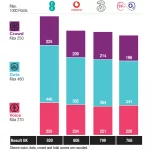Openreach Put the Brakes on Future UK G.fast Broadband Plans
Openreach (BT) has today informed ISPs that they are holding off giving any further guidance on future build plans for their hybrid fibre G.fast “ultrafast broadband” (100Mbps+) technology, which means that under the existing rollout they will only cover 2.73 million UK premises by March 2020..
The writing has been on the wall for awhile, not least since the last G.fast (ITU G.9700/9701) related rollout update was in November 2018 (here) and there have been no further updates (i.e. no new locations announced in 2019). The most recent coverage update confirmed that they had so far put the service within reach of 2,166,000 premises and the rollout pace was slowing (here).
Under the original plan Openreach had intended to push the 330Mbps capable G.fast service to reach 10 million UK premises by the end of 2020 (March 2021 financial), although pressure from competitors, Ofcom and the Government’s move to prioritise “full fibre” networks has combined to encourage a greater focus toward much more desirable Fibre-to-the-Premises (FTTP) lines.
Advertisement
In August 2018 this resulted in Openreach’s decision to revise down their G.fast rollout plan to just 5.7 million premises by March 2021 (here), while today’s decision means that no new locations are currently planned to be added to the build programme. As such they will continue to rollout until March 2020, when just 2.73m premises will have been covered.

Just to be clear, the G.fast rollout hasn’t yet stopped but any build plans beyond March 2020 are currently under review. A final decision on that review is expected to be communicated to ISPs by March 2020 but we’d be very surprised if that included a major expansion beyond the planned 2.73m premises (probably not to the previously expected 5.7m level).
As before the reason for all this stems from Openreach’s desire to focus on FTTP deployments and avoid overbuild, which is a positive. Lest we forget that last year’s move to scale-back the G.fast rollout was ultimately followed by the operator’s decision to raise their full fibre rollout to cover 4 million premises by March 2021 (up from 3m), including an ambition for 15 million by around 2025 (up from 10m) – here.
Advertisement
Admittedly we suspect that the mixed performance and limited take-up of the G.fast service itself, which only tends to be very good over shorter copper lines, probably hasn’t done much to help its future prospects. By comparison FTTP can easily handle multi-Gigabit or better speeds in the future and doesn’t suffer from the same reliability issues, plus take-up has been good.
The BT Group are currently in the process of restructuring and a lot of that focus has to do with raising money in order to fund their full fibre plans. Today’s predictable news very much plays into that effort.
Mark is a professional technology writer, IT consultant and computer engineer from Dorset (England), he also founded ISPreview in 1999 and enjoys analysing the latest telecoms and broadband developments. Find me on X (Twitter), Mastodon, Facebook, BlueSky, Threads.net and Linkedin.
« Cityfibre Bringing FTTH Broadband to Social Housing in Scotland
Vodafone UK Deploys Ultrafast 5G Mobile to Gatwick Airport »


















































Comments are closed